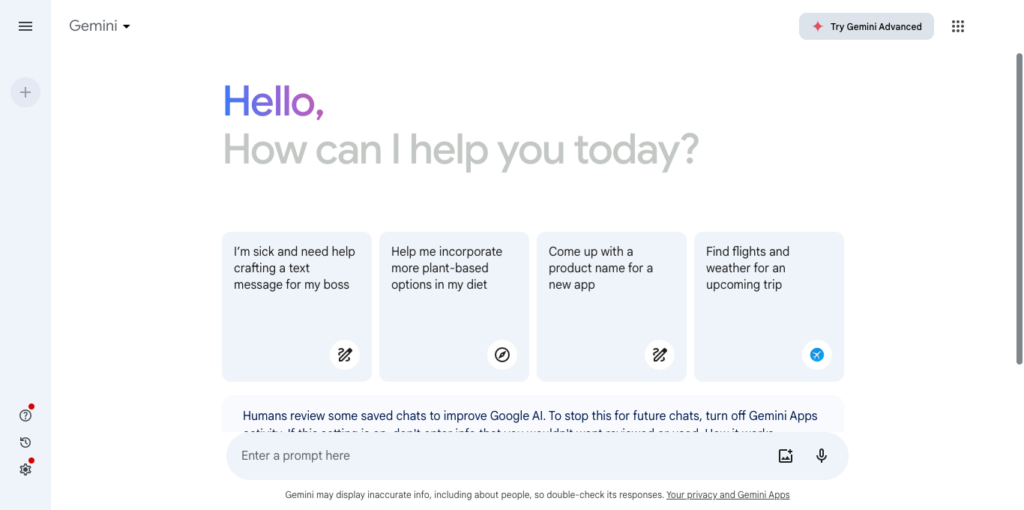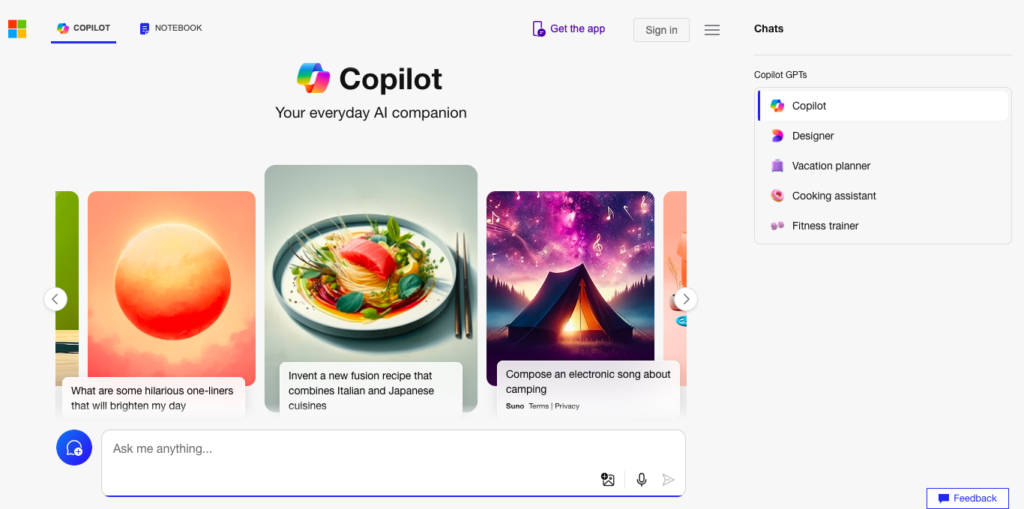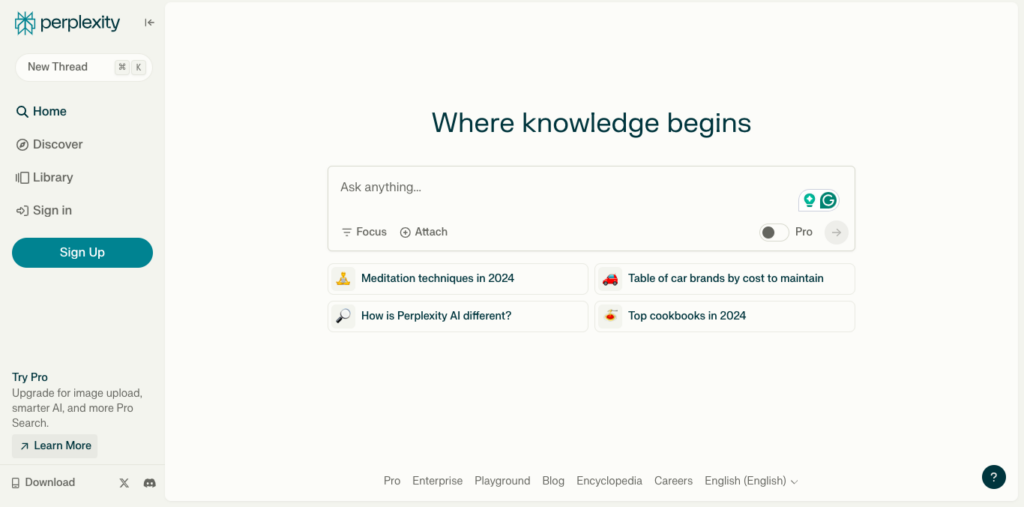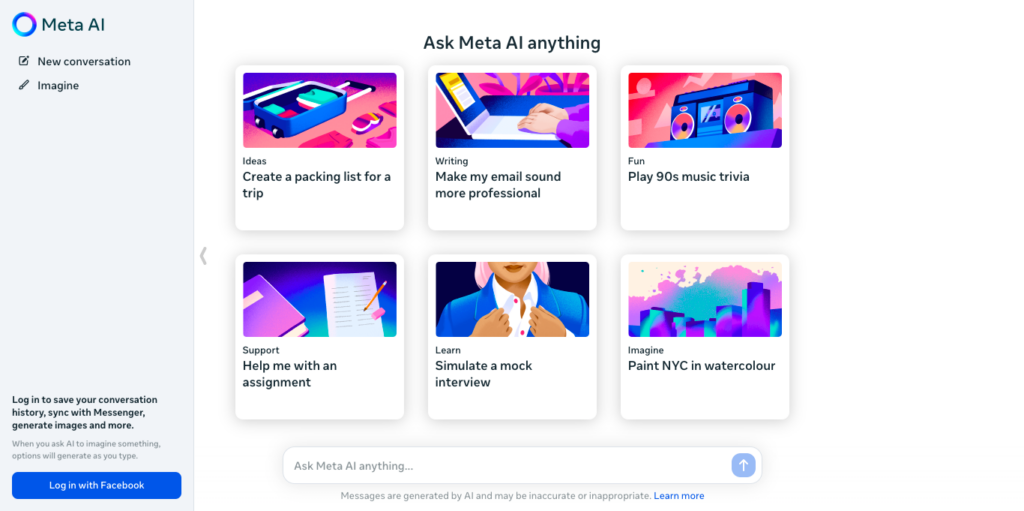Are you searching for the best ChatGPT alternatives of 2024? You’re looking for them because ChatGPT doesn’t quite fit your needs. Perhaps it’s the cost, the features, or just looking around at other options.

Relax, you are not alone, and you have come to the right place. Below is an article prepared to help you wade through this ocean of top alternatives, both free and paid, so that you get the perfect match for your requirements.
Whether it be better pricing, different capabilities, or just looking around, we have got your back.
Let’s get started.
1.) CraftBard AI:
CraftBard AI is state-of-the-art AI-driven instrumental text creation tool for marketers, freelancers, writers, developers, and entrepreneurs. It seeks to give an easier way of creating content in the digital space using advanced artificial intelligence techniques that can be used in easily generating high-quality texts.

Be it compelling blog posts, riveting marketing copies, or detailed reports—CraftBard AI has versatile solutions for your diversified needs.
Key Features:
- AI-Powered Text Generation: This technology creates relevant and compelling content through sophisticated algorithms.
- Customized outputs: Changeable to your wish for tone, style, and format.
- Multi-lingual Support: It can generate content in many languages.
- SEO Optimization: Built-in tools to enhance the SEO quality of your content.
- User-Friendly: Self-explanatory, intuitive design that is easy to navigate.
- Plagiarism Checker: It scans for the originality and uniqueness of all generated content.
- Content Templates: Predefined templates for different types of writing tasks.
- Real-Time Editing: Allows for immediate modifications and enhancements.
Pricing:
- Free: 5,000 words per month
- Basic: $8 for 150,000 words per month
- Pro: $20 for 500,000 words per month
Pros & Cons:
Pros:
- Generates high-quality, diverse content.
- User-friendly and intuitive interface.
- Supports multiple languages.
- SEO optimization features.
- Free tier available.
- Plagiarism detection.
Cons:
- Limited customization on the free tier.
- Occasional need for manual corrections.
Pro Tip:
To use CraftBard AI at maximum overdrive, begin by clearly defining the purpose and audience for your content. Utilize the customized output features to adjust the tone and style accordingly, and thus tailor the generated content to suit your brand voice. Leverage the SEO tools to enhance visibility and engage a wider audience more effectively.
2.) Anthropic Claude 3:
Claude 3 by Anthropic is an AI Language Model that understands and generates text similar to that written and spoken as done by humans.

Thereby, in honor of Claude Shannon, the father of information theory, this model comes to mean safe, reliable, and human-aligned AI interactions, very appropriate for applications demanding deep understanding and subtle responses.
Main Features:
- Advanced Natural Language Understanding: Capable of grasping complex queries and context.
- Safety and Alignment: This is designed with inherent safety protocols against such dangerous outputs.
- Human-Like Interaction: Generates responses that closely mimic human conversation.
- High level of personalization: Tailor-made responses to highly specific needs and contexts.
- Continuous Learning: Be updated regularly for improved performance.
- Broad Application Range: Suitable for customer service, content creation, and a lot more.
- Scalable Solutions: It scales up or down according to demand.
- Integration Capabilities: Easily integrated into already existing systems and platforms.
Pricing:
Claude 3 offers a flexible pricing structure.
- Free: Images and docs
- Basic: $20 for Everything
- Pro: $30 for Everything in Pro
Pros & Cons:
Pros:
- High level of natural language understanding.
- Focus on safety and ethical AI use.
- Customizable to fit specific applications.
- Suitable for a wide range of industries.
- Regular updates enhance performance.
Cons:
- Pricing may be on the higher side for small businesses.
- Initial setup may require technical expertise.
- Limited free usage.
Pro Tip:
With Claude 3 at your fingertips, interact with its tailored settings to get the AI to produce responses that better suit how it’s being used. Allow the AI to be consistently updated with new data so that it aligns its behaviors in line with changing needs and ensures relevance and accuracy in the responses.
3.) Google Gemini (formerly Bard):
Gemini, formerly Bard—developed by DeepMind—sets the most advanced AI model developed at Google. It is a multimodal AI that can understand and generate text, images, audio, video, and code. Gemini comes designed to provide sophisticated reasoning and coding capabilities, thus versatile for application in most industries.

Available in a range of different configurations to meet the requirements of highly complex tasks or highly efficient on-device operations, Gemini becomes the ultimate choice.
Key Features:
- Multimodal Capabilities: It can process text, images, audio, video, and code.
- Advanced Coding Skills: Capable of Handling Complex Tasks in Coding.
- Models Scalable: Ultra, Pro, Flash, Nano available.
- Long Context Windows: It also supports quite long context windows: up to a million tokens.
- High Performance: Excels in natural language understanding, math, and coding benchmarks.
- Integration with Google Products: It enhances services like Bard, Pixel 8 Pro, and Search Generative Experience.
- Developer Tools: Externally available with Gemini API vertex AI and Google AI Studio.
- Regular Updates: Continuously improved for better performance.
Pricing:
- Free: Help with writing, planning, learning and more
- Pro: $20 for 1.5 Pro, next-generation model with a 1M token context window
Pros & Cons:
Pros:
- High versatility due to multimodal capabilities.
- Excellent performance in various benchmarks.
- Supports long context windows.
- Available in different configurations to suit various needs.
- Enhances multiple Google products and services.
- Accessible through robust developer tools.
Cons:
- Requires technical expertise for integration and setup.
Pro Tip:
Google Gemini can be especially helpful when it is used for its multimodal capabilities within applications that entail text, image, audio, and video processing. Upgrade your model regularly with new data and use the different API tools available in Vertex AI and Google AI Studio to acquire both the best possible performance and a high degree of customizability.
4.) Microsoft Copilot:
Microsoft Copilot is an AI-powered assistant integrated into Microsoft 365 applications like Word, Excel, PowerPoint, Outlook, and Teams. It leverages advanced AI to boost productivity by automating routine tasks, generating insightful data analysis, and providing real-time assistance.

Copilot is designed to help users unlock creativity, enhance productivity, and gain deeper insights from their data with a simple chat-based interface.
Key Features:
- Contextual Understanding: Integrates with Microsoft 365 to provide relevant suggestions and automation.
- Data Analysis: Generates insights from Excel data and creates visualizations.
- Automated Content Creation: Assists in drafting documents, emails, and presentations.
- Meeting Summaries: Provides concise summaries of meetings and action items in Teams.
- Real-Time Collaboration: Enhances collaborative efforts with smart suggestions and automation.
- Task Management: Helps manage and prioritize tasks within Outlook.
- Seamless Integration: Works across various Microsoft 365 applications for a unified experience.
Pricing:
- Free: Help with writing, planning, learning, and more
- Pro: $20 for Microsoft Copilot Pro
Pros & Cons:
Pros:
- Deep integration with Microsoft 365 applications.
- Enhances productivity and creativity.
- Real-time assistance and automation.
- Excellent data analysis and visualization tools.
- Improves task and meeting management.
- User-friendly interface.
Cons:
- May involve a learning curve for new users.
- Limited customization options outside the Microsoft ecosystem.
Pro Tip:
Maximize Microsoft Copilot’s potential by fully integrating it into your daily workflow. Use it to automate repetitive tasks and generate insights from data to make informed decisions quickly. Explore all its features across different Microsoft 365 apps to enhance your productivity and collaboration efforts.
5.) Perplexity:
Perplexity AI is an advanced AI-powered search engine designed to provide real-time, contextual, and relevant information. It operates as an “answer engine,” offering users coherent answers with citations, making it an ideal tool for research and data retrieval.

Unlike traditional search engines, Perplexity AI focuses on delivering concise, ad-free results that prioritize authoritative sources.
Key Features:
- Real-Time Information Retrieval: Provides accurate, up-to-date answers with relevant context.
- Easy-to-Use Interface: User-friendly and maintains a conversational flow.
- Ad-Free Experience: Filters out promotional content for unbiased information.
- Cited Sources: Includes citations for all information, enhancing credibility.
- Integration with WolframAlpha: Enhances its data processing capabilities.
Pricing:
- Free Version: Available for all users.
- Pro Version: $20 per month, offering additional features and capabilities.
Pros & Cons:
Pros:
- Delivers contextual and relevant information.
- User-friendly interface and ad-free experience.
- Provides citations for all responses.
- Integrates well with other tools like WolframAlpha.
- Free version available with substantial features.
Cons:
- Sometimes generates extra details that may not be accurate.
- Lacks the vast amount of indexed data found in traditional search engines like Google.
- Sensitive to the size and diversity of its training datasets, which may affect the accuracy of certain responses.
Pro Tip:
To get the most accurate and useful results from Perplexity AI, be specific and clear with your prompts. Using detailed and structured inputs can significantly enhance the quality of the responses. This approach helps mitigate the occasional inaccuracies due to limited dataset diversity.
6.) Inflection Pi:
Inflection Pi is a personal AI designed to provide smart, supportive, and conversational assistance. Its primary aim is to create a reliable AI companion that can engage in meaningful conversations, provide advice, and answer questions in real-time.

Pi is accessible via desktop and mobile platforms, ensuring users can interact with their personal AI anytime and anywhere.
Key Features:
- Conversational AI: Engages in natural, flowing conversations.
- 24/7 Availability: Always ready to assist, regardless of time.
- Multi-Platform Support: Accessible via desktop, mobile, and messaging apps.
- Smart Assistance: Offers intelligent advice and answers based on the context.
- Privacy Focus: Strong measures to protect user data.
- Continuous Learning: Adapts and improves over time with user interactions.
Pricing:
- Pi AI is free to use.
Pros & Cons:
Pros:
- Engages in natural and meaningful conversations.
- Accessible on multiple platforms, including desktop and mobile.
- Provides smart and contextual advice.
- High focus on user privacy and data security.
- Continuous improvement through learning from user interactions.
Cons:
- May not always provide the most accurate responses due to limited datasets.
- Can be overly sensitive to conversational context, leading to irrelevant answers at times.
Pro Tip:
For the best experience with Inflection Pi, start by asking clear and specific questions. This helps the AI understand your needs better and provide more accurate and relevant answers. Regularly interacting with Pi will also help it learn your preferences and improve its responses over time.
7.) xAI Grok:
xAI Grok, developed by x.ai, is a state-of-the-art conversational AI designed to provide advanced reasoning and long-context understanding capabilities.

The latest version, Grok-1.5, excels in tasks involving coding, math, and complex problem-solving, thanks to its impressive benchmarks in HumanEval, GSM8K, and other tests.
Key Features
- Long Context Understanding: Processes contexts up to 128,000 tokens, making it ideal for handling long and complex prompts.
- Advanced Reasoning: Enhanced performance in coding and math-related tasks.
- Custom Training Framework: Built on a robust framework using JAX, Rust, and Kubernetes for efficient training.
- Improved Retrieval Capabilities: Demonstrates perfect retrieval results in Needle In A Haystack (NIAH) evaluation.
- High Performance Benchmarks: Scores 50.6% on MATH, 90% on GSM8K, and 74.1% on HumanEval benchmarks.
- Reliable Infrastructure: Custom orchestrator for maximizing training reliability and minimizing downtime.
Pricing
To access Grok, a subscription to X Premium or X Premium+ is required. Pricing details are available on the x.ai website.
Pros & Cons
Pros:
- Superior long-context processing
- High benchmark scores in coding and math tasks
- Advanced reasoning capabilities
- Reliable and efficient training infrastructure
- Perfect retrieval results for embedded text
- Built on a scalable and flexible custom framework
Cons:
- Requires X Premium subscription
- No REST API, only gRPC
- Limited access to the API
- Availability restricted to certain regions.
Pro Tip
To maximize the benefits of Grok, leverage its long-context understanding by feeding it large documents or extensive data. This capability is particularly useful for projects that require detailed analysis and comprehension of vast amounts of information, such as research papers, legal documents, or extensive coding projects.
8.) Llama 3:
Llama 3, developed by Meta, is an advanced language model designed to facilitate natural language understanding and generation tasks. It builds on the capabilities of its predecessors, providing more accurate and nuanced responses for a variety of applications.

It includes new prompt formats and special tokens to enhance its interaction quality and flexibility.
Key Features
- Advanced Prompting: Supports system and user message formats for detailed interactions.
- Enhanced Text Generation: Improved algorithms for more coherent and contextually relevant responses.
- Fine-Tuning: Customizable for specific use cases through fine-tuning.
- Multi-Turn Conversations: Capable of handling complex multi-turn dialogues.
- Community Support: Access to an open innovation AI research community.
- Integration Guides: Detailed guides for integrating Llama 3 into various applications.
- Safety Features: Equipped with Meta Llama Guard for responsible AI use.
- Quantization Options: Efficient deployment with reduced computational requirements.
Pricing
- Llama 3 is completely free.
Pros & Cons
Pros:
- Highly customizable for different tasks.
- Strong community and support network.
- Advanced conversational abilities.
- Efficient deployment options.
- Detailed integration documentation.
Cons:
- Requires significant computational resources for optimal performance.
- May need expert knowledge for fine-tuning.
- Potential ethical considerations in deployment.
Pro Tip
When using Llama 3, leverage its multi-turn conversation capabilities to build more engaging and interactive applications. Fine-tuning the model on your specific data can significantly improve its performance and relevance to your use case.
9.) MetaAI:
MetaAI, developed by Meta, encompasses a range of AI tools designed for advanced machine learning tasks. It aims to push the boundaries of AI research and application, providing robust solutions for various industries.

Key Features
- State-of-the-Art Models: Access to cutting-edge AI models for diverse applications.
- Research Support: Strong emphasis on AI research and development.
- Open Innovation Community: Collaborative platform for AI researchers and developers.
- Extensive Documentation: Comprehensive guides and resources for implementation.
- Ethical AI Use: Tools and guidelines for responsible AI deployment.
- Scalable Solutions: Suitable for both small-scale and enterprise-level applications.
- Training Resources: Access to training data and tools for model development.
- Community Grants: Funding opportunities for AI research projects.
Pricing
- MetaAI’s is completely free.
Pros & Cons
Pros:
- Access to leading AI technologies.
- Strong research and community support.
- Comprehensive resources and documentation.
- Ethical guidelines for AI use.
- Scalable and flexible solutions.
Cons:
- Potentially complex for beginners.
- Requires substantial resources for large-scale deployment.
- Ethical considerations in use and deployment.
Pro Tip
Utilize MetaAI’s extensive research resources and community support to stay updated with the latest advancements in AI. Engaging with the community can provide valuable insights and collaborative opportunities to enhance your projects.
10.) HuggingChat:
HuggingChat, by Hugging Face, is a versatile conversational AI model designed to facilitate natural language interactions. It integrates seamlessly with the Hugging Face ecosystem, providing robust tools for various language processing tasks.

Key Features
- Seamless Integration: Works well with Hugging Face’s ecosystem.
- Pre-trained Models: Access to a variety of pre-trained models.
- Fine-Tuning Options: Customizable for specific use cases.
- Community Support: Active community for support and collaboration.
- User-Friendly Interface: Easy to use and implement.
- Model Hub: Centralized repository for models and datasets.
- API Access: Flexible API for integration into applications.
- Ethical AI Use: Guidelines and tools for responsible AI deployment.
Pricing
Free: For everyone but with limited capabilities
Pro: $9/Month with advanced capabilities
Enterprise: $20/Month per user with advanced SSO and SAML Support
Pros & Cons
Pros:
- Extensive library of pre-trained models.
- Strong community and support network.
- User-friendly and easy to implement.
- Flexible and customizable.
- Ethical guidelines for AI use.
Cons:
- Advanced features may require a subscription.
- Potential learning curve for new users.
- Performance may vary based on model and use case.
- Requires careful handling of ethical considerations.
Pro Tip
Take advantage of Hugging Face’s Model Hub to explore and experiment with different models. Fine-tuning a pre-trained model can save time and resources while achieving high performance for specific tasks.
Final Words
In conclusion, choosing the best ChatGPT alternatives for 2024 means exploring various tools that fit your needs. Each option, like CraftBard AI with its SEO features and easy interface, offers unique strengths.
Whether you need safety, customization, or integration, these AI models can help.
Take your time to check them out based on what you need. CraftBard AI, for instance, is great for creating content and boosting your SEO. It’s user-friendly and can adjust to match your style.





